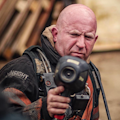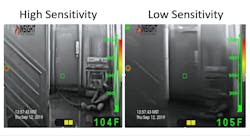Often, firefighters receive training that produces a false understanding of how a victim will present through the lens of a thermal imaging camera (TIC). This issue is compounded because many departments are limited in their live fire training.
Firefighters who never rescued a victim while they use a TIC will perceive a victim will be “white hot” in a fire because of their experiences from training with artificial smoke. This creates a false image of how a victim will appear in a superheated environment. Below are four steps to follow to ensure successful implementation of TIC use during search operations.
Choosing & understanding the TIC
A fire service TIC has defined limitations. It isn’t intended to be used as a thermometer and can’t see through objects. It’s a qualitative device that’s designed to see heat and view apparent temperatures across two or three spans (or temperature ranges) depending on its manufacturer. These devices provide “apparent temperatures,” which are uncompensated temperature measurements that can vary greatly from the actual temperature of the environment. As the overall amount of heat increases within the field of view of the TIC, it requires a gain change, or sensitivity change, that allows the device to focus in on the heat. When the TIC switches to low sensitivity, a loss of image clarity can occur in the cooler regions of the image (see above). As the overall heat increases within the field of view, the TIC switches to low sensitivity (which is indicated by a green triangle in the upper left-hand corner), and the device focuses in on the heat but loses detail in the cooler regions. This can cause firefighters to miss important details, such as victims, layout of the structure, holes in the floor, stairs and egress points.
TICs also vary in the following parameters: color/temperature correlation, field of view, refresh rate, resolution, temperature modes and thermal sensitivity. Therefore, to maximize clarity for the purposes of rescuing a victim and enhanced decision-making, firefighters should use a high-resolution decision-making TIC that meets or exceeds the 2021 requirements of NFPA 1801: Standard for Thermal Imagers for the Fire Service. Situational awareness TICs aren’t recommended for the purposes of tactical usage because of their lower resolution, slower refresh rate and smaller displays.
Proper TIC training & education
An industrial thermologist who works in the field must have a minimum of 32 hours of training on TICs to maintain a Level I Thermography Certification. However, firefighters often are placed in dangerous conditions without proper training, and they are expected to overcome this educational deficiency. This is gross negligence on the part of the fire department.
Firefighters should train on the use of their specific model and its specific features in the classroom, in hands-on training and in live fire training per NFPA 1408: Standard for Training Fire Service Personnel in the Operation, Care, Use, and Maintenance of Thermal Imagers. They should be properly trained in the concepts of heat, the key attributes of thermal imaging and the limitations/contraindications of fire service thermal imaging usage. An incident that occurs before the basic understanding of these concepts is instilled will result in misinterpretation and failure on the fireground.Conditions affect the victim
Overall background environmental conditions directly affect how the victim presents through the lens of a TIC. For example, if the overall background temperatures are greater than 200 degrees Fahrenheit, a 98.6-degree F victim will present dark or gray depending on the individual’s skin temperature and whether that person is clothed or covered by debris. (Note: Skin surface temperatures can vary between 92.3–98.4 degrees F.) Victims who are deceased for some time in a fire environment, which also are known as passive emitters, absorb energy but don’t emit energy on their own. They either blend in with the background or, eventually, heat up, depending on their proximity to the heat source.
The overall background temperature of the environment, the body temperature of the victim (alive or deceased) and the sensitivity mode of the TIC (high or low) all contribute to how the victim presents on the display of a TIC.
It’s recommended that departments stage victims (rescue manikins) in three different temperature ranges to demonstrate how victims appear through the lens of the TIC. Departments that use heated rescue manikins will find that the manikin will show up white initially. A cooled manikin will show up dark initially and then gradually heat up and blend in with the background, as a human body will do in a fire environment.
Tactical use of the TIC
Departments would be wise to use the data that are provided from Firefighter Rescue Survey regarding the location of victims who are rescued from a fire. This allows firefighters to have a search plan in their mind based on the conditions that are presented to them on arrival.
Firefighters should be properly trained to use the TIC for search but not during search. In other words, when firefighters move through the environment, the TIC should be stowed or away from their vision. It should be used in the following ways: as an initial scan on entry or when entering another space, to check conditions, to monitor crew progress and to locate secondary means of egress. The TIC shouldn’t be in front of the field of view of firefighters while they move.
The decision-making TIC should be in decision-makers’ hands (e.g., company officers or senior firefighters). The individuals should scan from low to high to maintain better visibility. They should wipe the lens periodically to prevent a loss of image detail from moisture/particulate build up. Firefighters might or might not see the victim with a TIC during their scan. However, if they locate a victim during their search, the TIC shall be used to identify the most tenable route to quickly remove the victim from these conditions. Keeping a victim low during the removal process could be the difference between the individual’s survival or demise.
Firefighters should train for TIC failure. Drills or scenarios should be conducted based on the following scenarios:
TIC failure. During a search, the TIC is removed from the company officer, and that person is asked to complete the search or find the way out without the assistance of the TIC. This instills a sense of competence in fundamental search methods while ensuring confidence in interpretation of data on a TIC to enhance search methods.
Depth perception issues. Drills or scenarios to demonstrate how a TIC can cause depth perception issues with objects that are closer than three feet away can include stairwell identification, zero-visibility forcible entry and firefighters who are entangled in wires who require extrication.
Reflection issues. An increase in shiny surfaces in structures creates the possibility of confusion and disorientation using a TIC. (Improved picture clarity of newer models of TICs makes it even more difficult for firefighters.) Areas that can cause confusion that have a large amount of metal or highly reflective surfaces are commercial kitchens, sunrooms, glass doors and fully tiled bathrooms that have glass doors. Reflections can be detected by either waving at the object or flowing water on both surfaces. Firefighters who wave at the reflection will see themselves. By flowing water on a heat source, the thermal gradient or pattern will change or diminish, but when water is directed at a reflection, the thermal gradient or pattern won’t diminish or change.
Know your TIC model
The aforementioned steps are listed to assist departments in training and educating their members on the tactical use of their specific TIC. It’s recommended to seek out brand-specific resources, because each model of TIC has distinct differences, and many have various additional features that could assist firefighters with tactical decision-making.
About the Author

Andrew Starnes
Andrew Starnes has been involved with the fire service as a volunteer since 1992 and as a career firefighter since 1998. He retired as a battalion chief and 25-year career with a large career department in North Carolina. Starnes is Level II Thermography Certified and is the founder of Insight Training LLC, which developed the first thermography-based firefighter certification that's credentialed through Infrared Training Center. He is a fire service website contributor on the topics of thermal imaging, fire behavior, leadership, behavioral health and faith-based devotions. Starnes has trained and/or assisted departments with thermal imaging training in all 50 states and in numerous other countries.

